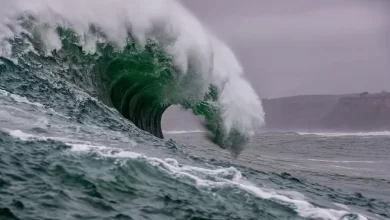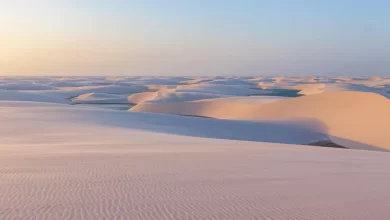A hurricane is a type of tropical cyclone that forms over tropical or subtropical waters. Tropical storms are defined as having maximum sustained winds of 39 mph or higher.A hurricane occurs when a storm’s maximum sustained winds exceed 74 mph.
- The different names of this destructive natural disaster are hurricane, tornado, and typhoon
- The things that are needed to form a hurricane are Warm ocean waters of at least 78°F (26°C), At least 5° latitude from the equator, Low vertical wind shear, Moisture in the mid-troposphere, Unstable Conditions, and Pre-existing disturbance.
- The English word “hurricane” comes from the Taino (the indigenous people of the Caribbean and Florida) word “Huricán,” who was the Caribbean Indian god of evil. The word was last modified in the 16th century, and from that time, the word hurricane is in use for this big natural disaster.
- There are five main categories of a hurricane.
• Category 1: Winds reach up to 120 to 153 km\h (74 to 95 mph) (Minor damage)
• Category 2: Winds reach up to 154 to 177 km\h ( 96 to 110 mph), which can lead to Extensive damage and can uproot trees and break windows)
• Category 3: Winds reach up to 179 to 208 km\h (111 to 129 mph ), which can lead to Devastating damage and can break windows and doors.
• Category 4: Winds reach up to 209 to 251 km\h (130 to 156 mph), which can lead to catastrophic damage and can tear off roofs and shelters.
• Category 5: Winds blow at a speed of more than 252.6 km\h (157 mph). The damage can be extreme and can level houses and destroy even buildings) - The wall of the eye is the most intense part of a hurricane. Whereas the eye of the storm is usually calm.
- The eye of a storm is a roughly circular area, typically 30–65 km\h (19–40 mph) in diameter. It is surrounded by the eyewall, a ring of towering thunderstorms where the most severe weather and highest winds occur.
- There is an effect known as the Fujiwara Effect, according to which two hurricanes merge into one and can thus have two eyes that merge into one.
- The deadliest storm in American history, the Galveston hurricane, killed 8,000 to 12,000 people.
- Hurricane starts to weaken down as soon as it touches the land.
- Hurricane San Roque which occurred in the year 1508, was the First recorded record of a hurricane that happened in Puerto Rico.
- Hurricanes are the only natural disasters that are given names.
- Hurricane occurs mainly in the tropical areas of our planet earth.
- In the year 1953, the United States began using female names for different hurricanes. By the year 1978, both male and female names were used to identify pacific storms. The same was being adopted for the Atlantic basin in the year 1979.
- In 1953, the United States began using female names for storms and, by 1978, both male and female names were used to identify Northern Pacific storms. This was then adopted in 1979 for storms in the Atlantic basin. NOAA’s National Hurricane Center does not control the naming of tropical storms.
- The Galveston Hurricane of 1900 remains the deadliest hurricane as well as the worst natural disaster in the history of the United States.
- The deadliest tropical cyclone ever recorded and one of the world’s deadliest natural disasters occurred in 1970 in Bangladesh and was named Bhola. More than 500,000 people lost their lives in the storm.
- The heat that is released because of a hurricane is equivalent to a 10-megaton nuclear bomb exploding every 20 minutes.
- Typhoon Tip was the largest and most intense tropical cyclone ever recorded. The huge storm had a diameter of 1,380 mi (2,220 km), and winds reached the speed of 305 km\h. The affected countries were Japan, the Philippines, Alaska, Guam, Korea, Northeast China, and Russia Far East.
- The longest-lasting tropical hurricane lasted for over 31 days, it was named Typhoon John, and the storm traveled through the eastern Pacific Ocean from August 11 – September 11, 1994. It also holds the record for being traveled the furthest distance by any other cyclone with 13,280 km.
- Tropical Storm Marco was the smallest hurricane by radius. The winds reached the speed of 100 km\h (65 mph) and were formed on October 6, 2008, in Mexico.
- Hurricane Jim, also known as the 2031 Surprise Hurricane, was the shortest-lived category 5 Atlantic hurricane on record and the fastest intensifying Atlantic hurricane on record. The hurricane reached the speed of 257 km\h (160 mph).
- In the Atlantic basin, the annual average is about six hurricanes. The Northwest Pacific sees by far the highest number of hurricanes each year, with an average of 16.5, while the North Indian Ocean sees the least, with an average of 1.5
References
- Britannica-Cyclone Meterology
- Wikipedia-Cyclone
- Wikipedia-Eye of the cyclone
- Wikipedia-Bhola Cyclone
- Bbc.com(the heat of a of a hurricane is equivalent to nuclear bombs)
- Wikipedia-Typhoon Tip
- Guinnessworldrecords.com(longest duration cyclone)
- Wikipedia-Tropical Storm Marco
- Hypotheticalhurricanes.fandom.com(shortest lived category 5 hurricane)






